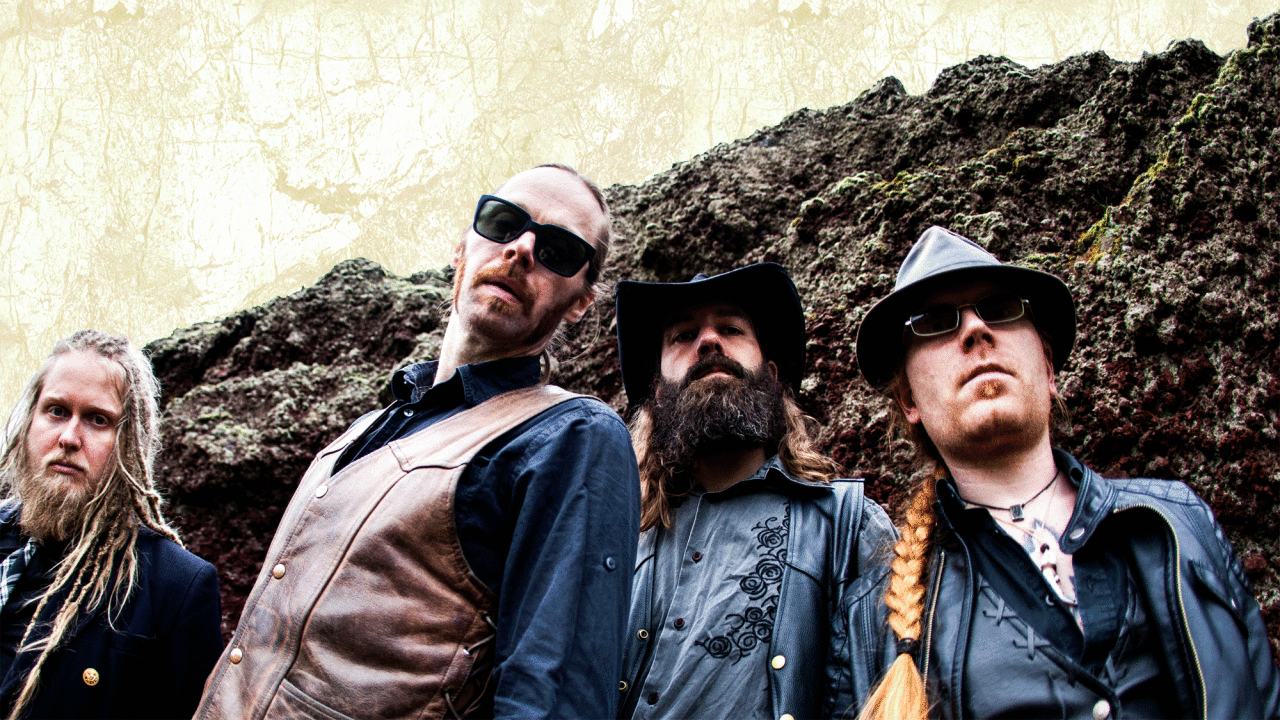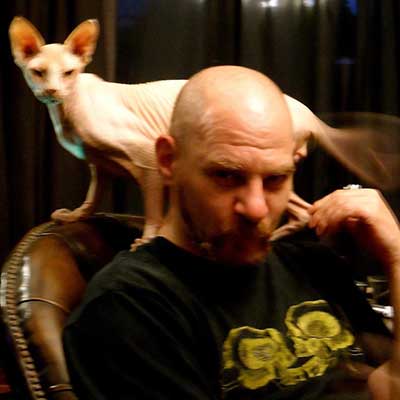Sólstafir are getting used to being the odd band out. Currently on a summer festival tour, they’ve played alongside acts as diverse as Saxon, Blues Pills, Marduk and Triptykon. They’ve hung out with Bolt Thrower at Party San Festival and in Finland, says frontman Aðalbjörn ‘Addi’ Tryggvason, “we had breakfast with Blur”.
But as much of an apparent anomaly as they’ve been on each bill, everyone who hears Sólstafir, from indie kids to bullet-belted dwellers of the underground, ‘gets’ them. And as far as they’ve journeyed from their black metal roots since their formation in Reykjavik in 1995, metalheads have taken them to their hearts, understanding the power of a band channelling a vast, enrapturing environment and feeling the pull of a vision that carves out an entire, expansive world to get lost in. Ironically billed at the same time as Emperor, whose frontman has also journeyed from black metal into virgin yet emotionally universal territory, Sólstafir have just played on Hellfest’s ‘black metal’ stage, to a marquee packed with thousands of pilgrims, and left a rent in the heart of each and every one of them. For Addi, this is now a common occurrence.
“I remember as well when we were playing Party San, Marduk and Dark Funeral were there and we were like Deep Purple next to them,” he remarks. “We were the lightest band on the bill! But still, people weren’t saying, ‘You’re too soft for us.’ It’s never been about that, it’s just an atmosphere that people like.”
Just as bands like Norway’s Ulver can move from their caustic roots into new, richly textured territory while still keeping the loyalty of their early fans, you’re likely to see people in Slayer and Darkthrone patches at Sólstafir gigs alongside all manner of spectators. Maybe that’s because metal fans respect an honesty of intent, no matter how far it takes them from the early blueprint, or maybe, for all the tangents Sólstafir have taken, everybody recognises a simple, common core.
“We still have a lot of rock’n’roll in our music,” says Addi. “Hellacopters are rock’n’roll and if my grandmother would ask what sort of music Marduk is, I’d say it’s rock’n’roll. So rock’n’roll is like the mothership that connects all these small divisions. But then lot of those divisions are stupid.
“I remember when I first heard the first Mogwai album,” he continues, explaining the band’s evolution, “and the track Mogwai Fear Satan. That had some impact. It’s a rock’n’roll band, but they’re not playing rock’n’roll. They’ve got distorted guitars and drums, but they’re not playing rock’n’roll, and in that sense, we are the same. I mean, we are a heavy metal band, but we’re not Judas Priest. So we’re a non-metal heavy metal band! People say, ‘Oh, you’re like Sigur Rós.’ No, hell, we’re not. We’re actually nothing like bands like Sigur Rós, because we are a metal band. We’re just not a Judas Priest-style heavy metal band.”
Rock’n’roll suggests something celebratory, a plugging into a well-mapped lineage, but Sólstafir’s music is achingly poignant, a journey into the wilderness that begins just after you’ve lost all your co-ordinates, and a search for new, soul-rebuilding marker points. Where 2009’s Köld album rode its luminous, overdriven guitars into vivid, sonic dust storms that wiped out all their tracks, its 2011 follow-up, Svartir Sandir, saw the band voyaging out into gentler yet no less devastating territory. With a whole new range of dynamics at its command, it was an album in symbiosis with the epic, humanity-dwarfing landscapes and ever-shifting, often ravaging weather patterns of their native Icelandic habitat, with an intimacy and sensitivity that saw the close-knit four-piece moving into spectacular, unmarked territory.
Even from their early days, Sólstafir have been determined not to get sidetracked from their muse. As Addi recalls, “We got an offer from a guy to do our logo. He was the guy who did all the logos: Emperor, Borknagar. They all look the same. Of course this was an honour back in the day because we were just 17-year-old kids. But then we thought, ‘Hold on a minute, we can’t do that.’ We’ve had offers from layout guys and we know the answer is no, because we know it’s not right, it’s not us. We want to do it connected to us from within, not getting too much external stuff into our own little band.”
Ótta, Sólstafir’s fifth album, is incontestable proof that allowing a band to follow their own path over time, utterly heedless of generic cul-de-sacs and undignified jostling at the riff-lending library, is the only route to creating genuine, lasting masterpieces once more. It’s also heartbreaking, rapt, humbly anthemic and binding; a beautiful, orphaned beacon enriched by tremulous strings and piano and, in the case of the title track, a banjo riff orbiting the searchlight guitars that will echo indefinitely throughout newly illuminated internal caverns. Ótta is a transformative experience you’ll find yourself clinging onto like a raft in a wide-open sea. As with all albums with the potential for timelessness, it reflects a very personal set of circumstances, recorded in the studio that Sigur Rós built themselves, but also in tune with the incalculable scope of their surroundings, the fact that they sing in their own native tongue, bringing a yet deeper level of connection.
“I guess there is something uniquely Icelandic about us,” says Addi. “It’s hard to explain, but we use the language and we’ve tapped into mythology, which is really Icelandic, and that connects to nature- worshipping, so it’s all part of the same thing. Sigur Rós have been very connected to nature as well. It’s landscape rock’n’roll. I mean, you can hear that we are clearly not from Grimsby. People say they don’t understand the lyrics, but it’s more natural to sing in your own language and I wouldn’t do this if it wasn’t from the heart. It’s a beautiful thing when people say, ‘I’ve got no idea what the guy is singing about, but it’s giving me instant goosebumps.’”
Anyone who’s been to Iceland will know that the experience is one of transition, between the innumerable varieties of landscape to the aforementioned vagaries of the weather. It’s a country you journey through, and Ótta asks you to do the same.
One thing we do focus on is not making the same song twice,” explains Addi. “We’re not going to have two deserts in a row; there’s got to be a mountain or a glacier, if you get my point. So we put a landscape to every song. It is a journey, for us as well. I always have this vision in my head: the perfect song, this sort of spiritual golden castle that I’m looking for. And sometimes you think you’re reaching it, and there are some moments where some spirit comes up in the studio. One day, [guitarist] Gringo comes up with stuff he wrote for banjo, and we’re like, ‘Dude, we can’t use this.’ And then again, we said, ‘Hold on a minute, this is a really cool hook and of course we can use it.’ There are no rules here. And all of a sudden he plays it and something comes to my head and I tune my guitar down to A, and we start jamming, and I don’t know, where the fuck does that come from? Why would you tune a guitar down to A after hearing a banjo riff? It’s just one of these things that you can’t explain. It’s the essence of being in a band. [Drummer] Gummi wrote some songs, and when you’re doing a song dedicated to a deceased friend of yours, you’re about to have some spiritual essence there.”
The rallying, tribe-uniting nature of their songs and their clear suitability to the open air have made Sólstafir, alongside Beastmilk, the lateral band of choice for festivals. But just as Svartir Sandir brought them to the attention of new audiences,_ Ótta_’s impossible-to-pin-down yet deeply resonant afterglow is a unique private experience, too.
“If you look at Pink Floyd,” concludes Addi, “they play Pink Floyd. Metallica aren’t a thrash metal band, they’re Metallica. Sigur Rós is Sigur Rós. I love that. It means the band is their own genre. We are very confident that we are our own beings. I believe that we stand on our own in those terms.”
Ótta is out now via Season Of Mist. Sólstafir play Damnation Festival in November

